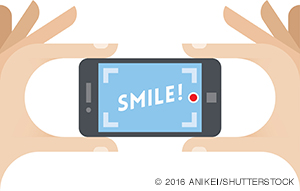
If you could watch a recording of your latest patient visit, would you be proud of your interpersonal skills?
Fam Pract Manag. 2016;23(6):40
Author disclosure: no relevant financial affiliations disclosed.

You may recall the old television series “Candid Camera,” where unsuspecting persons were caught on video in humorous scenarios and told to “Smile, you're on Candid Camera.” I wonder how many of our patient encounters would make us smile (or cringe) if we were able to watch them.
I have done video monitoring of residents in a family medicine residency program for well over a decade. (We always get permission, of course, and everyone is aware of the camera.) Although it can be intimidating, I am convinced that video monitoring is one of the most powerful ways to help physicians improve their interpersonal skills.
If your patient interactions were recorded today, what would an observer notice? Here are a few of the things we pay attention to with residents:
Physical proximity. We sometimes see residents get inside the patient's personal space, causing the patient to lean backward. It reminds me of a classic “Seinfeld” episode where the character Elaine has a boyfriend who invades everyone's space and is dubbed the “close talker.” On the other hand, we have witnessed residents standing clear across the room from the patient in a manner that may communicate, “I want to keep my distance from you.” The appropriate distance can vary according to culture, so pay attention to nonverbal cues. A good rule of thumb is to allow at least a couple feet between you and the patient.
Empathy. Our residents often think they are exhibiting genuine concern for patients, but when they watch the video, they are surprised at how cold, distracted, or indifferent they seem. Compassion fatigue and burnout only make matters worse. To truly express empathy, make a point of addressing the patient's situation, perspective, or feelings, such as “That must be frustrating” or “How are you feeling about that?”
Catch phrases. At times, we can all fall into the trap of overusing certain words or phrases (“To be honest with you…,” “You know…,” etc.). Years ago, we observed one resident who was in the habit of repeatedly saying, “I am not going to hurt you.” We knew what he meant – he was trying to put patients at ease – but it wasn't always appropriate. In fact, sometimes a doctor does have to cause some physical pain in order to do some healing procedures. If you aren't aware of your catch phrases, just ask your staff.
Listening. Would you be described as a good listener? It takes a lot of effort and energy to truly listen. We often notice residents stepping on patients' sentences or interpreting their statements or questions before they are finished. If you struggle with this type of behavior, it may indicate that you are in a hurry and failing to listen.
The patient's agenda. Many practices now call themselves a “patient-centered medical home.” If that is true, the practice should focus on the patient's needs and agenda. The patient's agenda may not always be realistic, however, so physicians have to help clarify and negotiate it at each visit. The key is to make the visit a dialogue rather than a monologue. If you were to play back one of your patient encounters, would you see a shared interaction, or would you see one person talking and directing (you) while the other person attempts to interject and eventually gives up?
As you take some time to mentally replay and reflect on your patient visits, I hope you are able to smile or laugh at your blunders without being too self-critical. None of us is perfect, but we can all do better. Approach your next patient visit as if you are on camera – and remember to smile.
